BSS057-6 Corporate Innovation: Creativity in Organizations Report
VerifiedAdded on 2023/06/07
|21
|5203
|388
Report
AI Summary
This report critically evaluates the support and barriers to creativity, innovation, and corporate entrepreneurship within organizations, using Google as a case study. It defines creativity as a blend of knowledge, imagination, and evaluation, and innovation as the implementation of creative ideas. The report examines Google's strategies for fostering a creative environment through employee satisfaction, careful recruitment, and positive leadership. It also addresses barriers to innovation, recommending the application of theories like the componential theory. The study emphasizes the importance of organizational climate in promoting innovation and suggests strategies for managing resistance to change and fostering open communication to encourage idea sharing and creative problem-solving. Ultimately, the report advocates for a strategic and collective effort to optimize business imperatives through a culture that values and rewards creativity.

Running Head: CREATIVITY AND INNOVATION IN ORGANIZATIONS
Creativity and Innovation in Organizations
Name of the Student
Name of the University
Author Note
Creativity and Innovation in Organizations
Name of the Student
Name of the University
Author Note
Paraphrase This Document
Need a fresh take? Get an instant paraphrase of this document with our AI Paraphraser
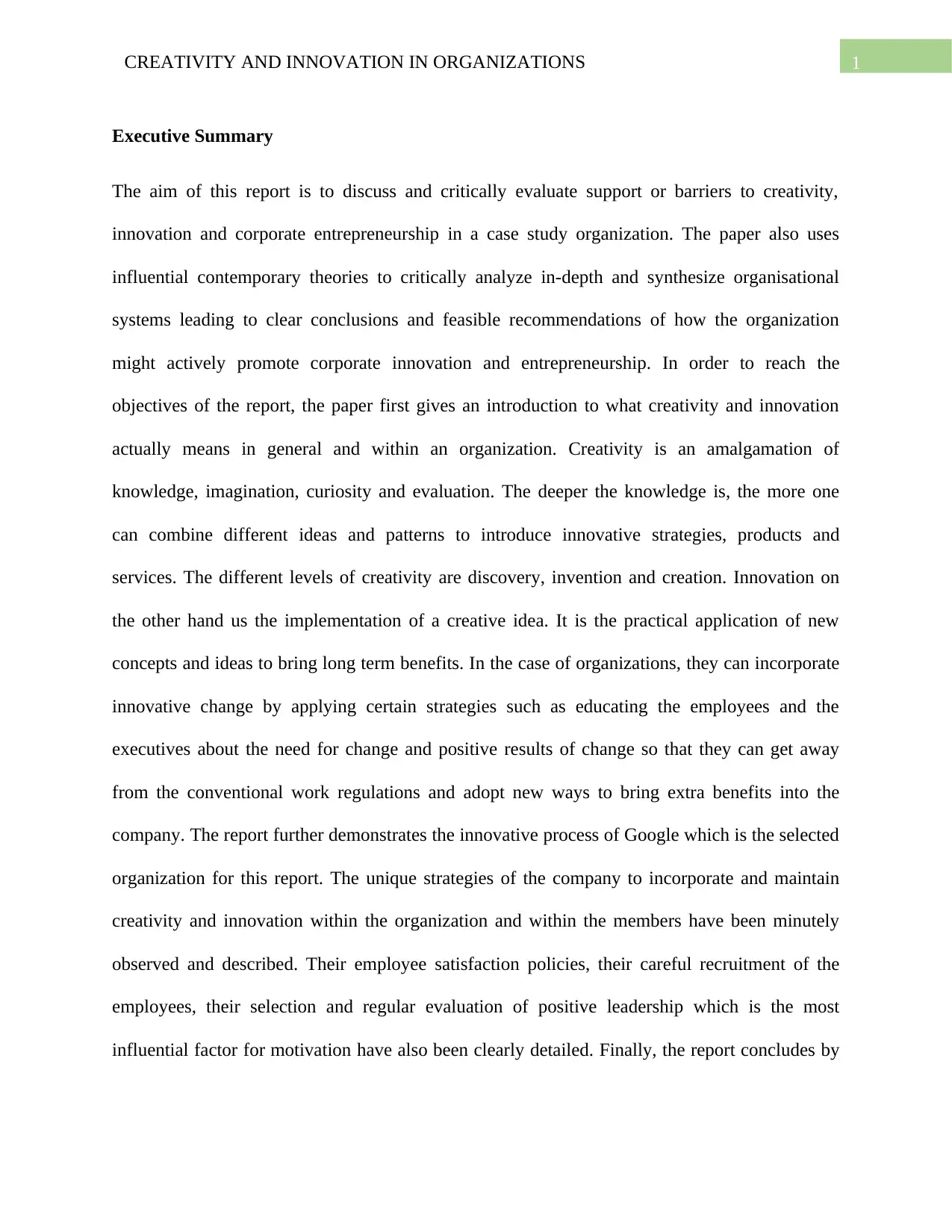
1CREATIVITY AND INNOVATION IN ORGANIZATIONS
Executive Summary
The aim of this report is to discuss and critically evaluate support or barriers to creativity,
innovation and corporate entrepreneurship in a case study organization. The paper also uses
influential contemporary theories to critically analyze in-depth and synthesize organisational
systems leading to clear conclusions and feasible recommendations of how the organization
might actively promote corporate innovation and entrepreneurship. In order to reach the
objectives of the report, the paper first gives an introduction to what creativity and innovation
actually means in general and within an organization. Creativity is an amalgamation of
knowledge, imagination, curiosity and evaluation. The deeper the knowledge is, the more one
can combine different ideas and patterns to introduce innovative strategies, products and
services. The different levels of creativity are discovery, invention and creation. Innovation on
the other hand us the implementation of a creative idea. It is the practical application of new
concepts and ideas to bring long term benefits. In the case of organizations, they can incorporate
innovative change by applying certain strategies such as educating the employees and the
executives about the need for change and positive results of change so that they can get away
from the conventional work regulations and adopt new ways to bring extra benefits into the
company. The report further demonstrates the innovative process of Google which is the selected
organization for this report. The unique strategies of the company to incorporate and maintain
creativity and innovation within the organization and within the members have been minutely
observed and described. Their employee satisfaction policies, their careful recruitment of the
employees, their selection and regular evaluation of positive leadership which is the most
influential factor for motivation have also been clearly detailed. Finally, the report concludes by
Executive Summary
The aim of this report is to discuss and critically evaluate support or barriers to creativity,
innovation and corporate entrepreneurship in a case study organization. The paper also uses
influential contemporary theories to critically analyze in-depth and synthesize organisational
systems leading to clear conclusions and feasible recommendations of how the organization
might actively promote corporate innovation and entrepreneurship. In order to reach the
objectives of the report, the paper first gives an introduction to what creativity and innovation
actually means in general and within an organization. Creativity is an amalgamation of
knowledge, imagination, curiosity and evaluation. The deeper the knowledge is, the more one
can combine different ideas and patterns to introduce innovative strategies, products and
services. The different levels of creativity are discovery, invention and creation. Innovation on
the other hand us the implementation of a creative idea. It is the practical application of new
concepts and ideas to bring long term benefits. In the case of organizations, they can incorporate
innovative change by applying certain strategies such as educating the employees and the
executives about the need for change and positive results of change so that they can get away
from the conventional work regulations and adopt new ways to bring extra benefits into the
company. The report further demonstrates the innovative process of Google which is the selected
organization for this report. The unique strategies of the company to incorporate and maintain
creativity and innovation within the organization and within the members have been minutely
observed and described. Their employee satisfaction policies, their careful recruitment of the
employees, their selection and regular evaluation of positive leadership which is the most
influential factor for motivation have also been clearly detailed. Finally, the report concludes by
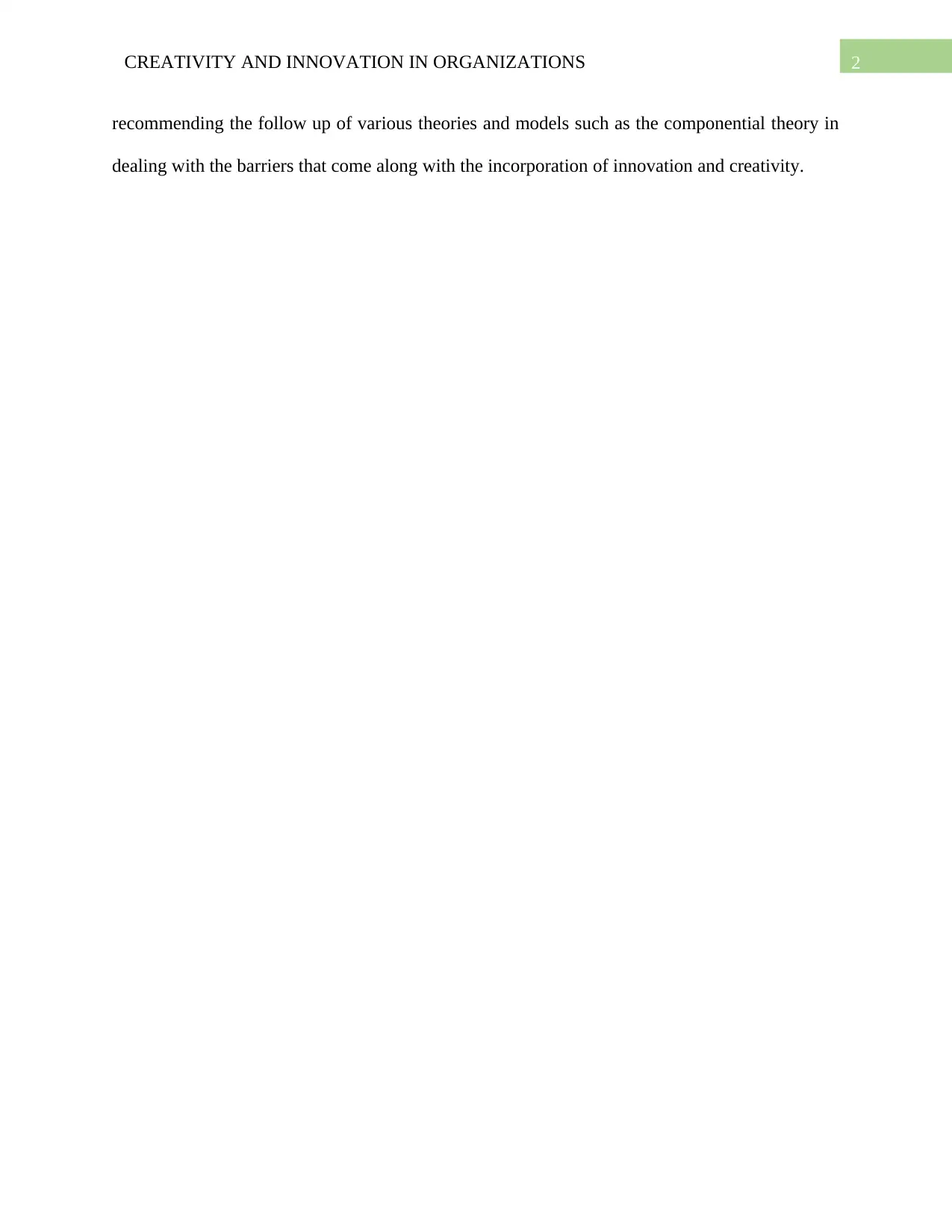
2CREATIVITY AND INNOVATION IN ORGANIZATIONS
recommending the follow up of various theories and models such as the componential theory in
dealing with the barriers that come along with the incorporation of innovation and creativity.
recommending the follow up of various theories and models such as the componential theory in
dealing with the barriers that come along with the incorporation of innovation and creativity.
⊘ This is a preview!⊘
Do you want full access?
Subscribe today to unlock all pages.

Trusted by 1+ million students worldwide
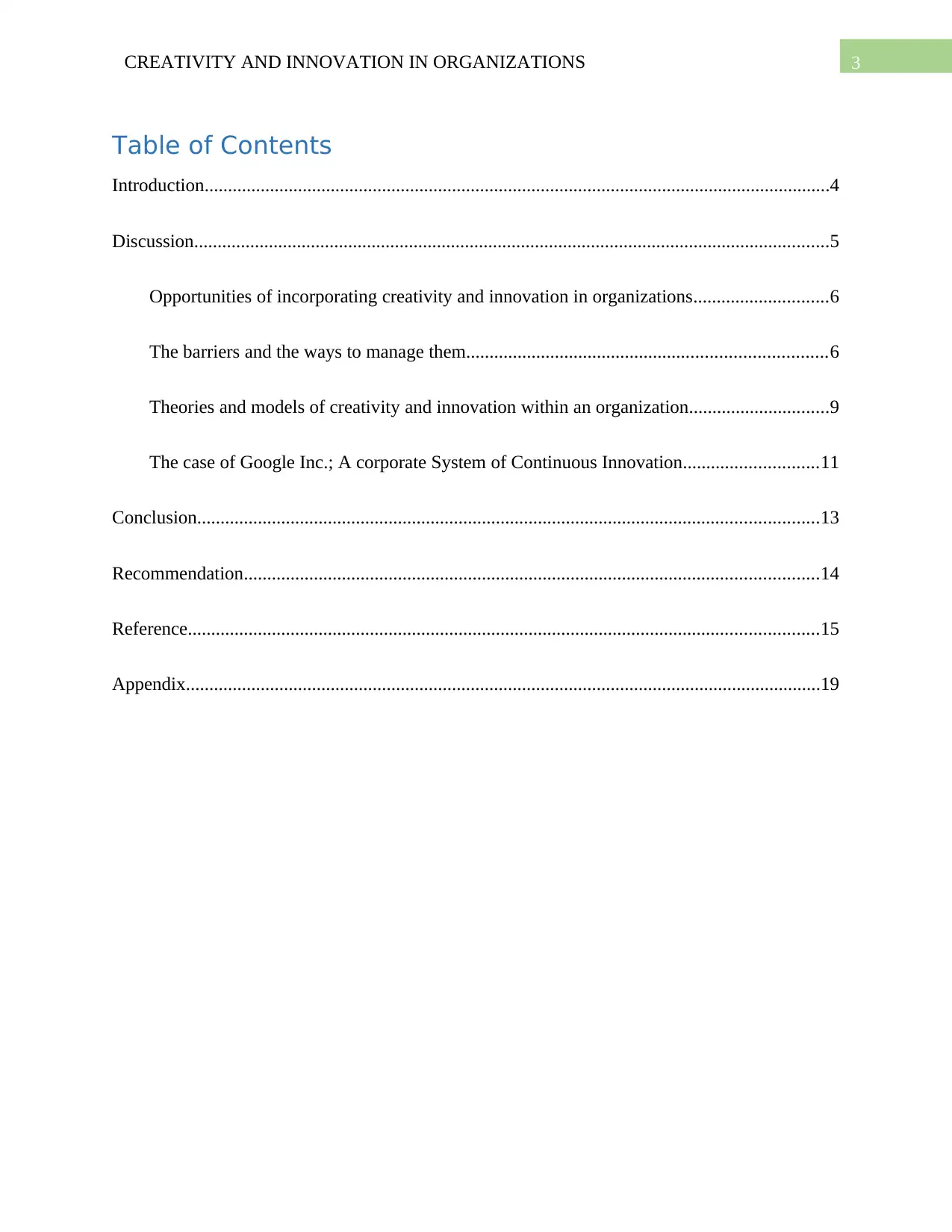
3CREATIVITY AND INNOVATION IN ORGANIZATIONS
Table of Contents
Introduction......................................................................................................................................4
Discussion........................................................................................................................................5
Opportunities of incorporating creativity and innovation in organizations.............................6
The barriers and the ways to manage them.............................................................................6
Theories and models of creativity and innovation within an organization..............................9
The case of Google Inc.; A corporate System of Continuous Innovation.............................11
Conclusion.....................................................................................................................................13
Recommendation...........................................................................................................................14
Reference.......................................................................................................................................15
Appendix........................................................................................................................................19
Table of Contents
Introduction......................................................................................................................................4
Discussion........................................................................................................................................5
Opportunities of incorporating creativity and innovation in organizations.............................6
The barriers and the ways to manage them.............................................................................6
Theories and models of creativity and innovation within an organization..............................9
The case of Google Inc.; A corporate System of Continuous Innovation.............................11
Conclusion.....................................................................................................................................13
Recommendation...........................................................................................................................14
Reference.......................................................................................................................................15
Appendix........................................................................................................................................19
Paraphrase This Document
Need a fresh take? Get an instant paraphrase of this document with our AI Paraphraser
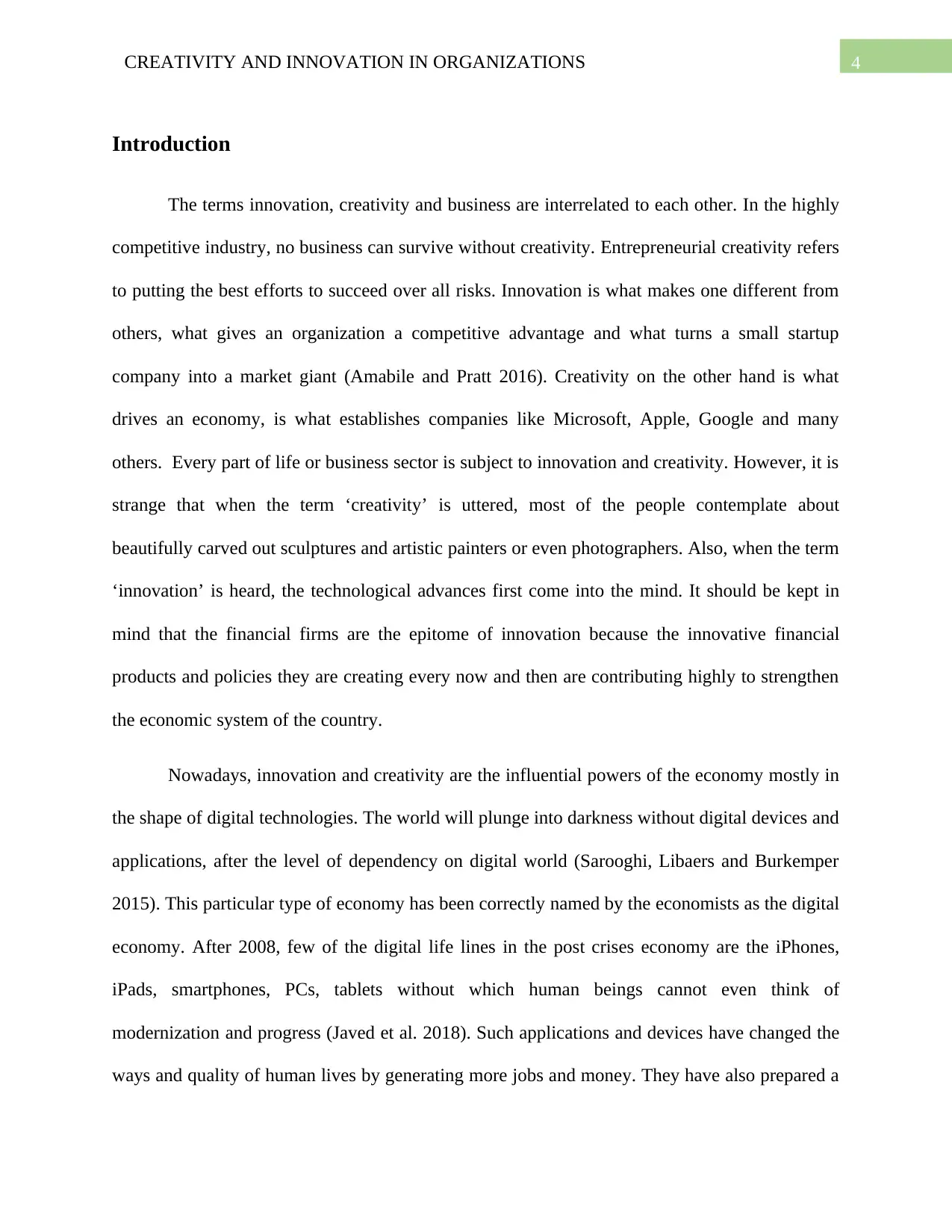
4CREATIVITY AND INNOVATION IN ORGANIZATIONS
Introduction
The terms innovation, creativity and business are interrelated to each other. In the highly
competitive industry, no business can survive without creativity. Entrepreneurial creativity refers
to putting the best efforts to succeed over all risks. Innovation is what makes one different from
others, what gives an organization a competitive advantage and what turns a small startup
company into a market giant (Amabile and Pratt 2016). Creativity on the other hand is what
drives an economy, is what establishes companies like Microsoft, Apple, Google and many
others. Every part of life or business sector is subject to innovation and creativity. However, it is
strange that when the term ‘creativity’ is uttered, most of the people contemplate about
beautifully carved out sculptures and artistic painters or even photographers. Also, when the term
‘innovation’ is heard, the technological advances first come into the mind. It should be kept in
mind that the financial firms are the epitome of innovation because the innovative financial
products and policies they are creating every now and then are contributing highly to strengthen
the economic system of the country.
Nowadays, innovation and creativity are the influential powers of the economy mostly in
the shape of digital technologies. The world will plunge into darkness without digital devices and
applications, after the level of dependency on digital world (Sarooghi, Libaers and Burkemper
2015). This particular type of economy has been correctly named by the economists as the digital
economy. After 2008, few of the digital life lines in the post crises economy are the iPhones,
iPads, smartphones, PCs, tablets without which human beings cannot even think of
modernization and progress (Javed et al. 2018). Such applications and devices have changed the
ways and quality of human lives by generating more jobs and money. They have also prepared a
Introduction
The terms innovation, creativity and business are interrelated to each other. In the highly
competitive industry, no business can survive without creativity. Entrepreneurial creativity refers
to putting the best efforts to succeed over all risks. Innovation is what makes one different from
others, what gives an organization a competitive advantage and what turns a small startup
company into a market giant (Amabile and Pratt 2016). Creativity on the other hand is what
drives an economy, is what establishes companies like Microsoft, Apple, Google and many
others. Every part of life or business sector is subject to innovation and creativity. However, it is
strange that when the term ‘creativity’ is uttered, most of the people contemplate about
beautifully carved out sculptures and artistic painters or even photographers. Also, when the term
‘innovation’ is heard, the technological advances first come into the mind. It should be kept in
mind that the financial firms are the epitome of innovation because the innovative financial
products and policies they are creating every now and then are contributing highly to strengthen
the economic system of the country.
Nowadays, innovation and creativity are the influential powers of the economy mostly in
the shape of digital technologies. The world will plunge into darkness without digital devices and
applications, after the level of dependency on digital world (Sarooghi, Libaers and Burkemper
2015). This particular type of economy has been correctly named by the economists as the digital
economy. After 2008, few of the digital life lines in the post crises economy are the iPhones,
iPads, smartphones, PCs, tablets without which human beings cannot even think of
modernization and progress (Javed et al. 2018). Such applications and devices have changed the
ways and quality of human lives by generating more jobs and money. They have also prepared a
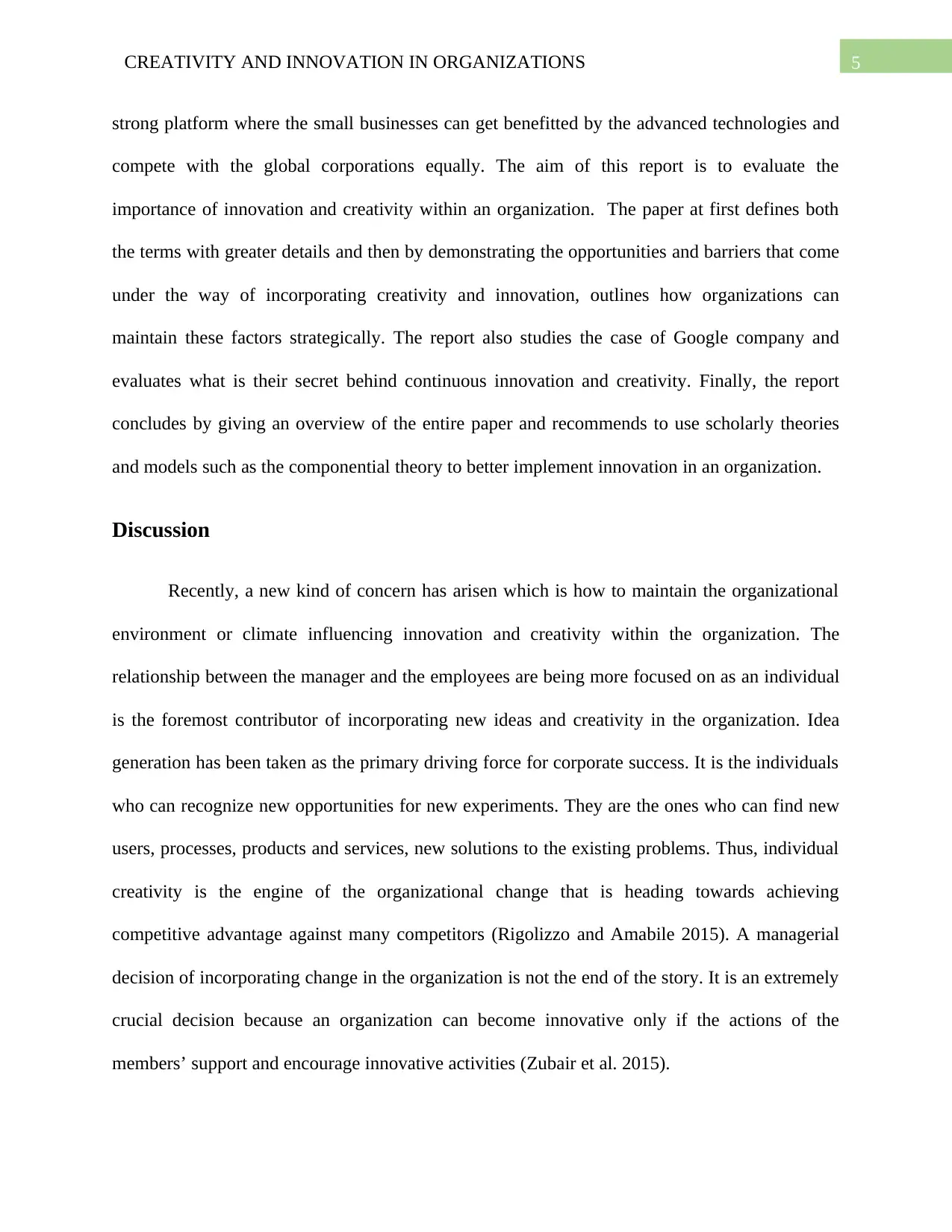
5CREATIVITY AND INNOVATION IN ORGANIZATIONS
strong platform where the small businesses can get benefitted by the advanced technologies and
compete with the global corporations equally. The aim of this report is to evaluate the
importance of innovation and creativity within an organization. The paper at first defines both
the terms with greater details and then by demonstrating the opportunities and barriers that come
under the way of incorporating creativity and innovation, outlines how organizations can
maintain these factors strategically. The report also studies the case of Google company and
evaluates what is their secret behind continuous innovation and creativity. Finally, the report
concludes by giving an overview of the entire paper and recommends to use scholarly theories
and models such as the componential theory to better implement innovation in an organization.
Discussion
Recently, a new kind of concern has arisen which is how to maintain the organizational
environment or climate influencing innovation and creativity within the organization. The
relationship between the manager and the employees are being more focused on as an individual
is the foremost contributor of incorporating new ideas and creativity in the organization. Idea
generation has been taken as the primary driving force for corporate success. It is the individuals
who can recognize new opportunities for new experiments. They are the ones who can find new
users, processes, products and services, new solutions to the existing problems. Thus, individual
creativity is the engine of the organizational change that is heading towards achieving
competitive advantage against many competitors (Rigolizzo and Amabile 2015). A managerial
decision of incorporating change in the organization is not the end of the story. It is an extremely
crucial decision because an organization can become innovative only if the actions of the
members’ support and encourage innovative activities (Zubair et al. 2015).
strong platform where the small businesses can get benefitted by the advanced technologies and
compete with the global corporations equally. The aim of this report is to evaluate the
importance of innovation and creativity within an organization. The paper at first defines both
the terms with greater details and then by demonstrating the opportunities and barriers that come
under the way of incorporating creativity and innovation, outlines how organizations can
maintain these factors strategically. The report also studies the case of Google company and
evaluates what is their secret behind continuous innovation and creativity. Finally, the report
concludes by giving an overview of the entire paper and recommends to use scholarly theories
and models such as the componential theory to better implement innovation in an organization.
Discussion
Recently, a new kind of concern has arisen which is how to maintain the organizational
environment or climate influencing innovation and creativity within the organization. The
relationship between the manager and the employees are being more focused on as an individual
is the foremost contributor of incorporating new ideas and creativity in the organization. Idea
generation has been taken as the primary driving force for corporate success. It is the individuals
who can recognize new opportunities for new experiments. They are the ones who can find new
users, processes, products and services, new solutions to the existing problems. Thus, individual
creativity is the engine of the organizational change that is heading towards achieving
competitive advantage against many competitors (Rigolizzo and Amabile 2015). A managerial
decision of incorporating change in the organization is not the end of the story. It is an extremely
crucial decision because an organization can become innovative only if the actions of the
members’ support and encourage innovative activities (Zubair et al. 2015).
⊘ This is a preview!⊘
Do you want full access?
Subscribe today to unlock all pages.

Trusted by 1+ million students worldwide
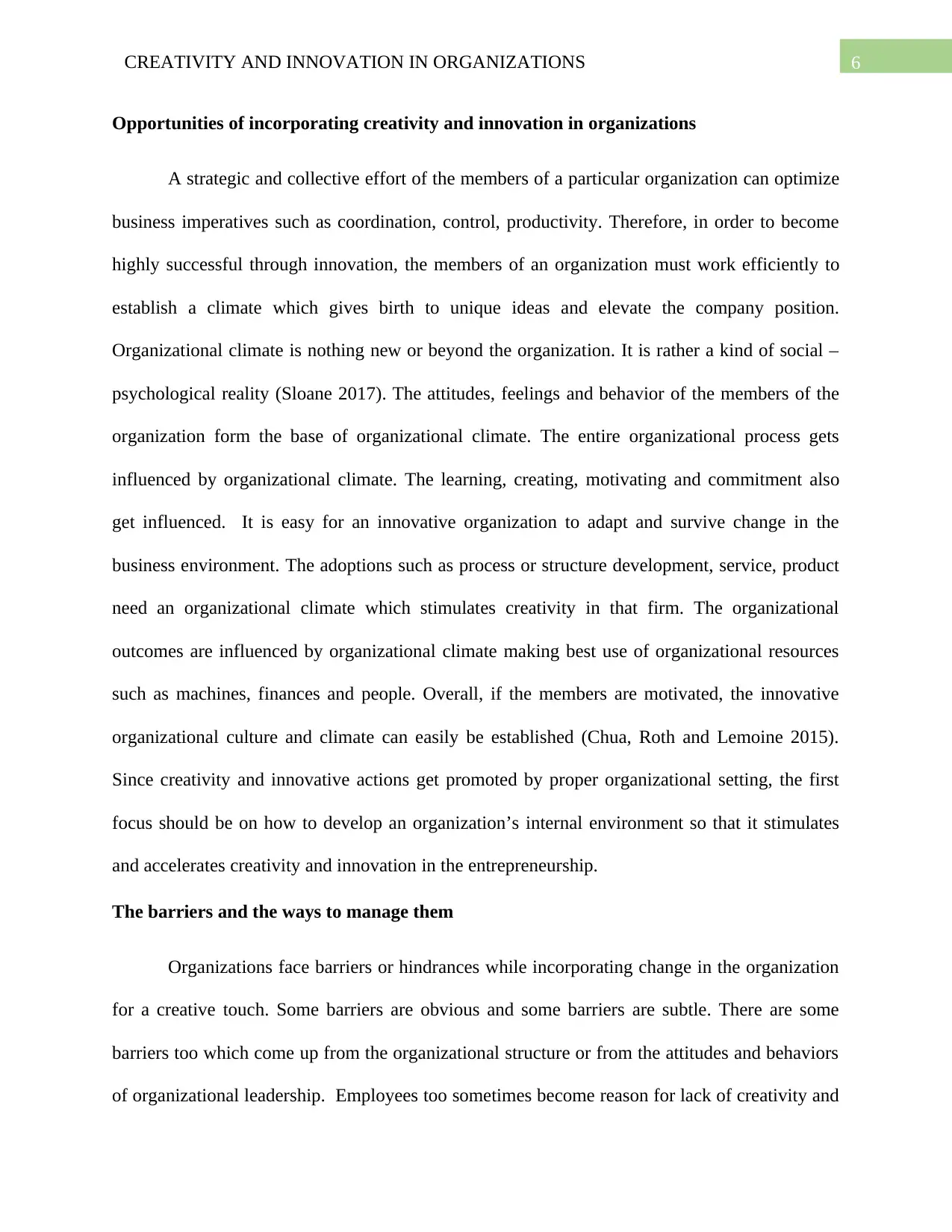
6CREATIVITY AND INNOVATION IN ORGANIZATIONS
Opportunities of incorporating creativity and innovation in organizations
A strategic and collective effort of the members of a particular organization can optimize
business imperatives such as coordination, control, productivity. Therefore, in order to become
highly successful through innovation, the members of an organization must work efficiently to
establish a climate which gives birth to unique ideas and elevate the company position.
Organizational climate is nothing new or beyond the organization. It is rather a kind of social –
psychological reality (Sloane 2017). The attitudes, feelings and behavior of the members of the
organization form the base of organizational climate. The entire organizational process gets
influenced by organizational climate. The learning, creating, motivating and commitment also
get influenced. It is easy for an innovative organization to adapt and survive change in the
business environment. The adoptions such as process or structure development, service, product
need an organizational climate which stimulates creativity in that firm. The organizational
outcomes are influenced by organizational climate making best use of organizational resources
such as machines, finances and people. Overall, if the members are motivated, the innovative
organizational culture and climate can easily be established (Chua, Roth and Lemoine 2015).
Since creativity and innovative actions get promoted by proper organizational setting, the first
focus should be on how to develop an organization’s internal environment so that it stimulates
and accelerates creativity and innovation in the entrepreneurship.
The barriers and the ways to manage them
Organizations face barriers or hindrances while incorporating change in the organization
for a creative touch. Some barriers are obvious and some barriers are subtle. There are some
barriers too which come up from the organizational structure or from the attitudes and behaviors
of organizational leadership. Employees too sometimes become reason for lack of creativity and
Opportunities of incorporating creativity and innovation in organizations
A strategic and collective effort of the members of a particular organization can optimize
business imperatives such as coordination, control, productivity. Therefore, in order to become
highly successful through innovation, the members of an organization must work efficiently to
establish a climate which gives birth to unique ideas and elevate the company position.
Organizational climate is nothing new or beyond the organization. It is rather a kind of social –
psychological reality (Sloane 2017). The attitudes, feelings and behavior of the members of the
organization form the base of organizational climate. The entire organizational process gets
influenced by organizational climate. The learning, creating, motivating and commitment also
get influenced. It is easy for an innovative organization to adapt and survive change in the
business environment. The adoptions such as process or structure development, service, product
need an organizational climate which stimulates creativity in that firm. The organizational
outcomes are influenced by organizational climate making best use of organizational resources
such as machines, finances and people. Overall, if the members are motivated, the innovative
organizational culture and climate can easily be established (Chua, Roth and Lemoine 2015).
Since creativity and innovative actions get promoted by proper organizational setting, the first
focus should be on how to develop an organization’s internal environment so that it stimulates
and accelerates creativity and innovation in the entrepreneurship.
The barriers and the ways to manage them
Organizations face barriers or hindrances while incorporating change in the organization
for a creative touch. Some barriers are obvious and some barriers are subtle. There are some
barriers too which come up from the organizational structure or from the attitudes and behaviors
of organizational leadership. Employees too sometimes become reason for lack of creativity and
Paraphrase This Document
Need a fresh take? Get an instant paraphrase of this document with our AI Paraphraser
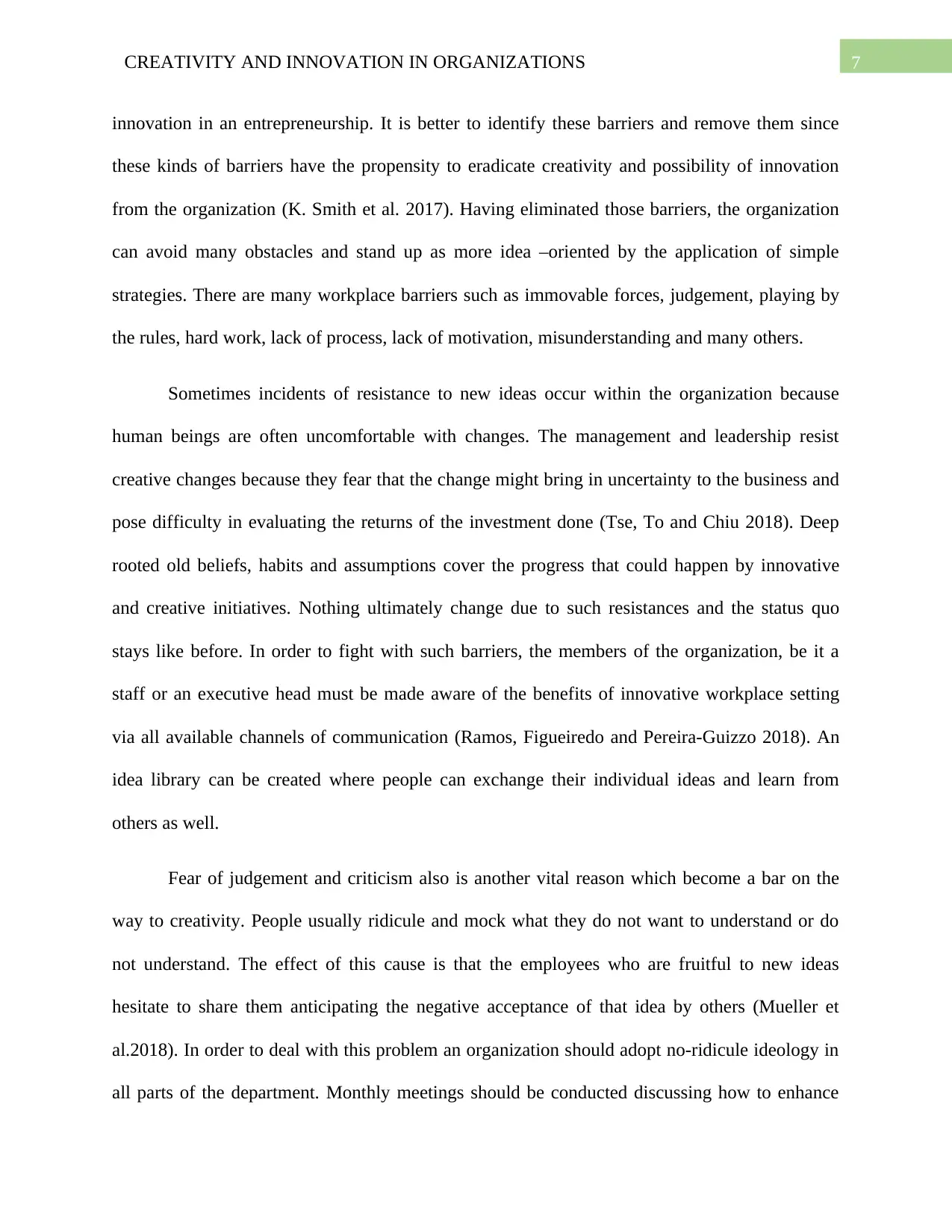
7CREATIVITY AND INNOVATION IN ORGANIZATIONS
innovation in an entrepreneurship. It is better to identify these barriers and remove them since
these kinds of barriers have the propensity to eradicate creativity and possibility of innovation
from the organization (K. Smith et al. 2017). Having eliminated those barriers, the organization
can avoid many obstacles and stand up as more idea –oriented by the application of simple
strategies. There are many workplace barriers such as immovable forces, judgement, playing by
the rules, hard work, lack of process, lack of motivation, misunderstanding and many others.
Sometimes incidents of resistance to new ideas occur within the organization because
human beings are often uncomfortable with changes. The management and leadership resist
creative changes because they fear that the change might bring in uncertainty to the business and
pose difficulty in evaluating the returns of the investment done (Tse, To and Chiu 2018). Deep
rooted old beliefs, habits and assumptions cover the progress that could happen by innovative
and creative initiatives. Nothing ultimately change due to such resistances and the status quo
stays like before. In order to fight with such barriers, the members of the organization, be it a
staff or an executive head must be made aware of the benefits of innovative workplace setting
via all available channels of communication (Ramos, Figueiredo and Pereira-Guizzo 2018). An
idea library can be created where people can exchange their individual ideas and learn from
others as well.
Fear of judgement and criticism also is another vital reason which become a bar on the
way to creativity. People usually ridicule and mock what they do not want to understand or do
not understand. The effect of this cause is that the employees who are fruitful to new ideas
hesitate to share them anticipating the negative acceptance of that idea by others (Mueller et
al.2018). In order to deal with this problem an organization should adopt no-ridicule ideology in
all parts of the department. Monthly meetings should be conducted discussing how to enhance
innovation in an entrepreneurship. It is better to identify these barriers and remove them since
these kinds of barriers have the propensity to eradicate creativity and possibility of innovation
from the organization (K. Smith et al. 2017). Having eliminated those barriers, the organization
can avoid many obstacles and stand up as more idea –oriented by the application of simple
strategies. There are many workplace barriers such as immovable forces, judgement, playing by
the rules, hard work, lack of process, lack of motivation, misunderstanding and many others.
Sometimes incidents of resistance to new ideas occur within the organization because
human beings are often uncomfortable with changes. The management and leadership resist
creative changes because they fear that the change might bring in uncertainty to the business and
pose difficulty in evaluating the returns of the investment done (Tse, To and Chiu 2018). Deep
rooted old beliefs, habits and assumptions cover the progress that could happen by innovative
and creative initiatives. Nothing ultimately change due to such resistances and the status quo
stays like before. In order to fight with such barriers, the members of the organization, be it a
staff or an executive head must be made aware of the benefits of innovative workplace setting
via all available channels of communication (Ramos, Figueiredo and Pereira-Guizzo 2018). An
idea library can be created where people can exchange their individual ideas and learn from
others as well.
Fear of judgement and criticism also is another vital reason which become a bar on the
way to creativity. People usually ridicule and mock what they do not want to understand or do
not understand. The effect of this cause is that the employees who are fruitful to new ideas
hesitate to share them anticipating the negative acceptance of that idea by others (Mueller et
al.2018). In order to deal with this problem an organization should adopt no-ridicule ideology in
all parts of the department. Monthly meetings should be conducted discussing how to enhance
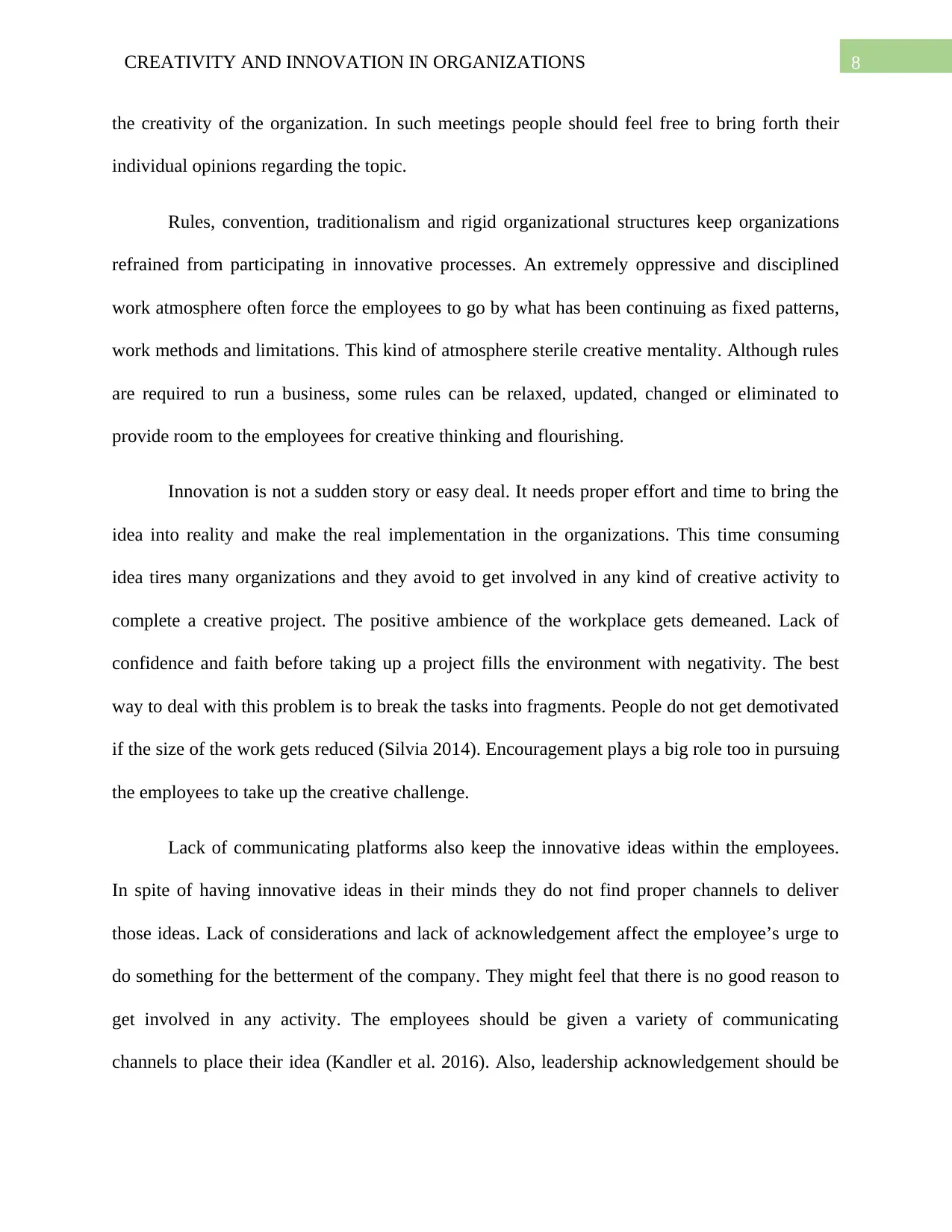
8CREATIVITY AND INNOVATION IN ORGANIZATIONS
the creativity of the organization. In such meetings people should feel free to bring forth their
individual opinions regarding the topic.
Rules, convention, traditionalism and rigid organizational structures keep organizations
refrained from participating in innovative processes. An extremely oppressive and disciplined
work atmosphere often force the employees to go by what has been continuing as fixed patterns,
work methods and limitations. This kind of atmosphere sterile creative mentality. Although rules
are required to run a business, some rules can be relaxed, updated, changed or eliminated to
provide room to the employees for creative thinking and flourishing.
Innovation is not a sudden story or easy deal. It needs proper effort and time to bring the
idea into reality and make the real implementation in the organizations. This time consuming
idea tires many organizations and they avoid to get involved in any kind of creative activity to
complete a creative project. The positive ambience of the workplace gets demeaned. Lack of
confidence and faith before taking up a project fills the environment with negativity. The best
way to deal with this problem is to break the tasks into fragments. People do not get demotivated
if the size of the work gets reduced (Silvia 2014). Encouragement plays a big role too in pursuing
the employees to take up the creative challenge.
Lack of communicating platforms also keep the innovative ideas within the employees.
In spite of having innovative ideas in their minds they do not find proper channels to deliver
those ideas. Lack of considerations and lack of acknowledgement affect the employee’s urge to
do something for the betterment of the company. They might feel that there is no good reason to
get involved in any activity. The employees should be given a variety of communicating
channels to place their idea (Kandler et al. 2016). Also, leadership acknowledgement should be
the creativity of the organization. In such meetings people should feel free to bring forth their
individual opinions regarding the topic.
Rules, convention, traditionalism and rigid organizational structures keep organizations
refrained from participating in innovative processes. An extremely oppressive and disciplined
work atmosphere often force the employees to go by what has been continuing as fixed patterns,
work methods and limitations. This kind of atmosphere sterile creative mentality. Although rules
are required to run a business, some rules can be relaxed, updated, changed or eliminated to
provide room to the employees for creative thinking and flourishing.
Innovation is not a sudden story or easy deal. It needs proper effort and time to bring the
idea into reality and make the real implementation in the organizations. This time consuming
idea tires many organizations and they avoid to get involved in any kind of creative activity to
complete a creative project. The positive ambience of the workplace gets demeaned. Lack of
confidence and faith before taking up a project fills the environment with negativity. The best
way to deal with this problem is to break the tasks into fragments. People do not get demotivated
if the size of the work gets reduced (Silvia 2014). Encouragement plays a big role too in pursuing
the employees to take up the creative challenge.
Lack of communicating platforms also keep the innovative ideas within the employees.
In spite of having innovative ideas in their minds they do not find proper channels to deliver
those ideas. Lack of considerations and lack of acknowledgement affect the employee’s urge to
do something for the betterment of the company. They might feel that there is no good reason to
get involved in any activity. The employees should be given a variety of communicating
channels to place their idea (Kandler et al. 2016). Also, leadership acknowledgement should be
⊘ This is a preview!⊘
Do you want full access?
Subscribe today to unlock all pages.

Trusted by 1+ million students worldwide
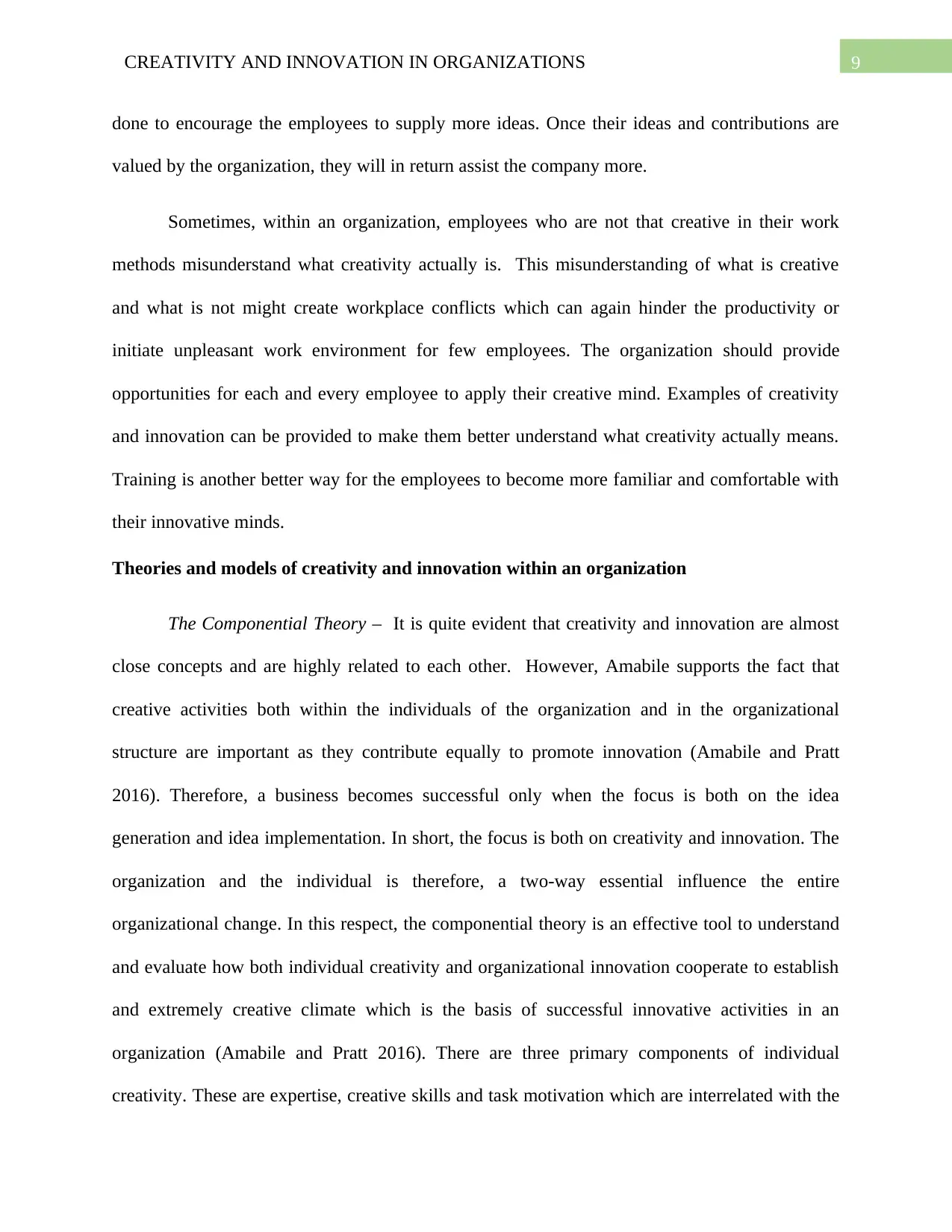
9CREATIVITY AND INNOVATION IN ORGANIZATIONS
done to encourage the employees to supply more ideas. Once their ideas and contributions are
valued by the organization, they will in return assist the company more.
Sometimes, within an organization, employees who are not that creative in their work
methods misunderstand what creativity actually is. This misunderstanding of what is creative
and what is not might create workplace conflicts which can again hinder the productivity or
initiate unpleasant work environment for few employees. The organization should provide
opportunities for each and every employee to apply their creative mind. Examples of creativity
and innovation can be provided to make them better understand what creativity actually means.
Training is another better way for the employees to become more familiar and comfortable with
their innovative minds.
Theories and models of creativity and innovation within an organization
The Componential Theory – It is quite evident that creativity and innovation are almost
close concepts and are highly related to each other. However, Amabile supports the fact that
creative activities both within the individuals of the organization and in the organizational
structure are important as they contribute equally to promote innovation (Amabile and Pratt
2016). Therefore, a business becomes successful only when the focus is both on the idea
generation and idea implementation. In short, the focus is both on creativity and innovation. The
organization and the individual is therefore, a two-way essential influence the entire
organizational change. In this respect, the componential theory is an effective tool to understand
and evaluate how both individual creativity and organizational innovation cooperate to establish
and extremely creative climate which is the basis of successful innovative activities in an
organization (Amabile and Pratt 2016). There are three primary components of individual
creativity. These are expertise, creative skills and task motivation which are interrelated with the
done to encourage the employees to supply more ideas. Once their ideas and contributions are
valued by the organization, they will in return assist the company more.
Sometimes, within an organization, employees who are not that creative in their work
methods misunderstand what creativity actually is. This misunderstanding of what is creative
and what is not might create workplace conflicts which can again hinder the productivity or
initiate unpleasant work environment for few employees. The organization should provide
opportunities for each and every employee to apply their creative mind. Examples of creativity
and innovation can be provided to make them better understand what creativity actually means.
Training is another better way for the employees to become more familiar and comfortable with
their innovative minds.
Theories and models of creativity and innovation within an organization
The Componential Theory – It is quite evident that creativity and innovation are almost
close concepts and are highly related to each other. However, Amabile supports the fact that
creative activities both within the individuals of the organization and in the organizational
structure are important as they contribute equally to promote innovation (Amabile and Pratt
2016). Therefore, a business becomes successful only when the focus is both on the idea
generation and idea implementation. In short, the focus is both on creativity and innovation. The
organization and the individual is therefore, a two-way essential influence the entire
organizational change. In this respect, the componential theory is an effective tool to understand
and evaluate how both individual creativity and organizational innovation cooperate to establish
and extremely creative climate which is the basis of successful innovative activities in an
organization (Amabile and Pratt 2016). There are three primary components of individual
creativity. These are expertise, creative skills and task motivation which are interrelated with the
Paraphrase This Document
Need a fresh take? Get an instant paraphrase of this document with our AI Paraphraser
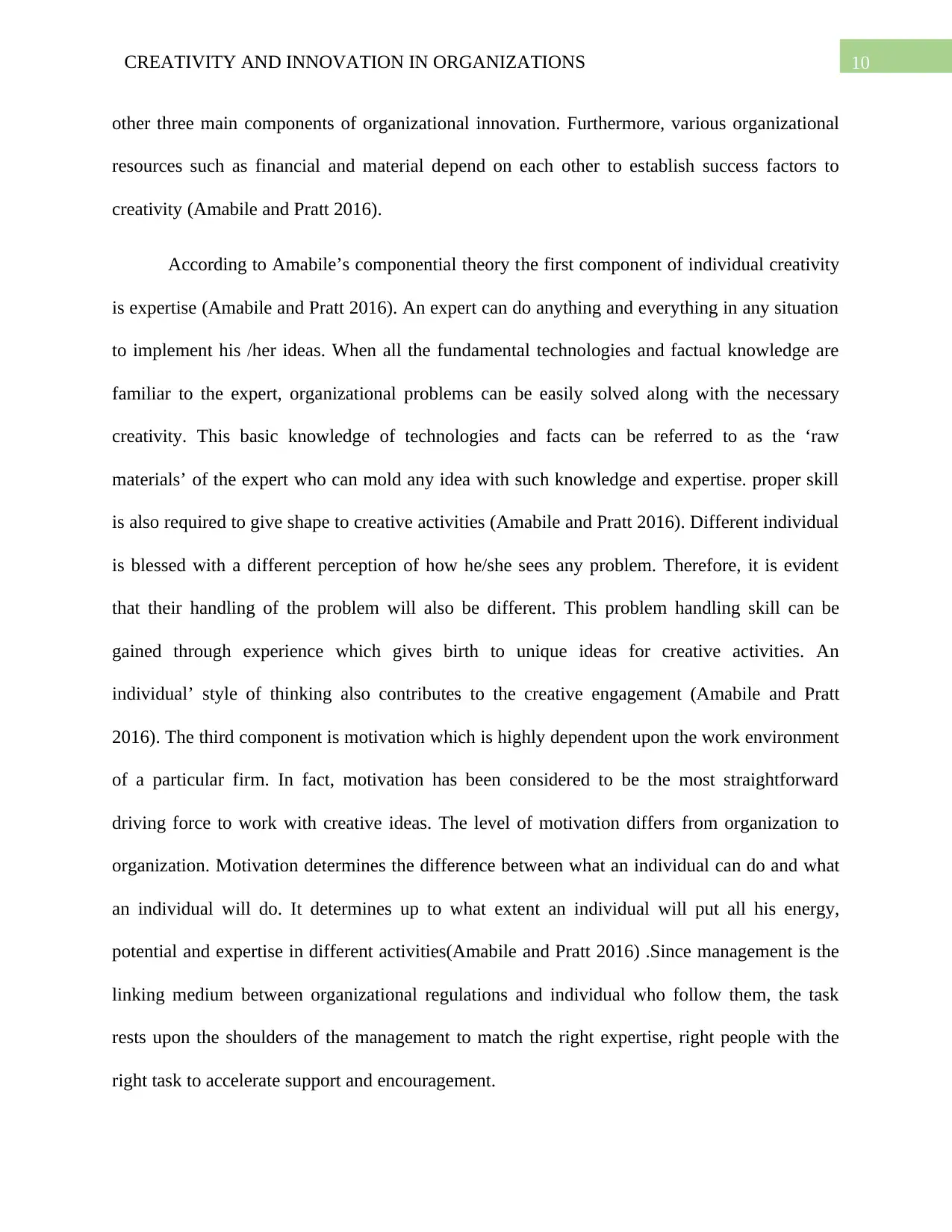
10CREATIVITY AND INNOVATION IN ORGANIZATIONS
other three main components of organizational innovation. Furthermore, various organizational
resources such as financial and material depend on each other to establish success factors to
creativity (Amabile and Pratt 2016).
According to Amabile’s componential theory the first component of individual creativity
is expertise (Amabile and Pratt 2016). An expert can do anything and everything in any situation
to implement his /her ideas. When all the fundamental technologies and factual knowledge are
familiar to the expert, organizational problems can be easily solved along with the necessary
creativity. This basic knowledge of technologies and facts can be referred to as the ‘raw
materials’ of the expert who can mold any idea with such knowledge and expertise. proper skill
is also required to give shape to creative activities (Amabile and Pratt 2016). Different individual
is blessed with a different perception of how he/she sees any problem. Therefore, it is evident
that their handling of the problem will also be different. This problem handling skill can be
gained through experience which gives birth to unique ideas for creative activities. An
individual’ style of thinking also contributes to the creative engagement (Amabile and Pratt
2016). The third component is motivation which is highly dependent upon the work environment
of a particular firm. In fact, motivation has been considered to be the most straightforward
driving force to work with creative ideas. The level of motivation differs from organization to
organization. Motivation determines the difference between what an individual can do and what
an individual will do. It determines up to what extent an individual will put all his energy,
potential and expertise in different activities(Amabile and Pratt 2016) .Since management is the
linking medium between organizational regulations and individual who follow them, the task
rests upon the shoulders of the management to match the right expertise, right people with the
right task to accelerate support and encouragement.
other three main components of organizational innovation. Furthermore, various organizational
resources such as financial and material depend on each other to establish success factors to
creativity (Amabile and Pratt 2016).
According to Amabile’s componential theory the first component of individual creativity
is expertise (Amabile and Pratt 2016). An expert can do anything and everything in any situation
to implement his /her ideas. When all the fundamental technologies and factual knowledge are
familiar to the expert, organizational problems can be easily solved along with the necessary
creativity. This basic knowledge of technologies and facts can be referred to as the ‘raw
materials’ of the expert who can mold any idea with such knowledge and expertise. proper skill
is also required to give shape to creative activities (Amabile and Pratt 2016). Different individual
is blessed with a different perception of how he/she sees any problem. Therefore, it is evident
that their handling of the problem will also be different. This problem handling skill can be
gained through experience which gives birth to unique ideas for creative activities. An
individual’ style of thinking also contributes to the creative engagement (Amabile and Pratt
2016). The third component is motivation which is highly dependent upon the work environment
of a particular firm. In fact, motivation has been considered to be the most straightforward
driving force to work with creative ideas. The level of motivation differs from organization to
organization. Motivation determines the difference between what an individual can do and what
an individual will do. It determines up to what extent an individual will put all his energy,
potential and expertise in different activities(Amabile and Pratt 2016) .Since management is the
linking medium between organizational regulations and individual who follow them, the task
rests upon the shoulders of the management to match the right expertise, right people with the
right task to accelerate support and encouragement.
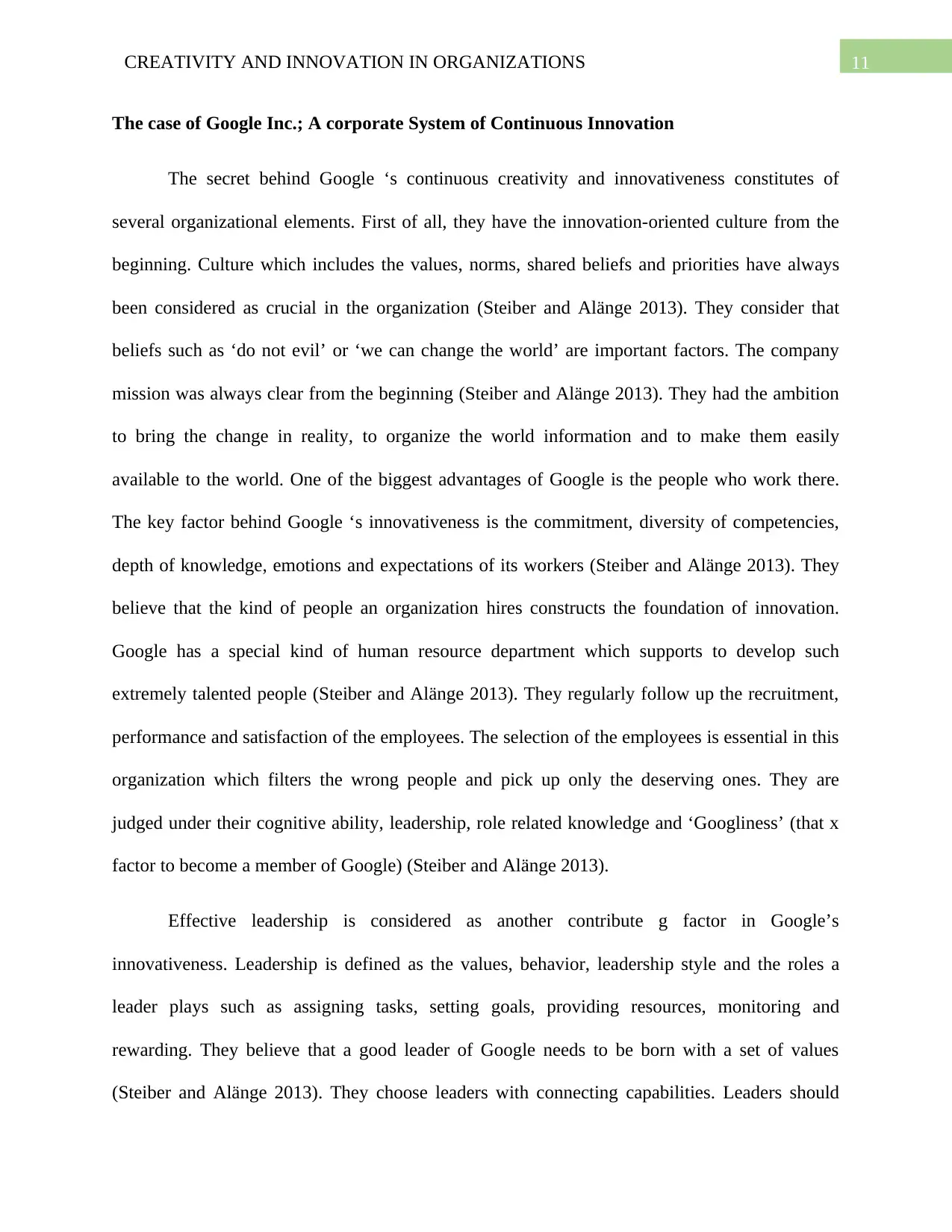
11CREATIVITY AND INNOVATION IN ORGANIZATIONS
The case of Google Inc.; A corporate System of Continuous Innovation
The secret behind Google ‘s continuous creativity and innovativeness constitutes of
several organizational elements. First of all, they have the innovation-oriented culture from the
beginning. Culture which includes the values, norms, shared beliefs and priorities have always
been considered as crucial in the organization (Steiber and Alänge 2013). They consider that
beliefs such as ‘do not evil’ or ‘we can change the world’ are important factors. The company
mission was always clear from the beginning (Steiber and Alänge 2013). They had the ambition
to bring the change in reality, to organize the world information and to make them easily
available to the world. One of the biggest advantages of Google is the people who work there.
The key factor behind Google ‘s innovativeness is the commitment, diversity of competencies,
depth of knowledge, emotions and expectations of its workers (Steiber and Alänge 2013). They
believe that the kind of people an organization hires constructs the foundation of innovation.
Google has a special kind of human resource department which supports to develop such
extremely talented people (Steiber and Alänge 2013). They regularly follow up the recruitment,
performance and satisfaction of the employees. The selection of the employees is essential in this
organization which filters the wrong people and pick up only the deserving ones. They are
judged under their cognitive ability, leadership, role related knowledge and ‘Googliness’ (that x
factor to become a member of Google) (Steiber and Alänge 2013).
Effective leadership is considered as another contribute g factor in Google’s
innovativeness. Leadership is defined as the values, behavior, leadership style and the roles a
leader plays such as assigning tasks, setting goals, providing resources, monitoring and
rewarding. They believe that a good leader of Google needs to be born with a set of values
(Steiber and Alänge 2013). They choose leaders with connecting capabilities. Leaders should
The case of Google Inc.; A corporate System of Continuous Innovation
The secret behind Google ‘s continuous creativity and innovativeness constitutes of
several organizational elements. First of all, they have the innovation-oriented culture from the
beginning. Culture which includes the values, norms, shared beliefs and priorities have always
been considered as crucial in the organization (Steiber and Alänge 2013). They consider that
beliefs such as ‘do not evil’ or ‘we can change the world’ are important factors. The company
mission was always clear from the beginning (Steiber and Alänge 2013). They had the ambition
to bring the change in reality, to organize the world information and to make them easily
available to the world. One of the biggest advantages of Google is the people who work there.
The key factor behind Google ‘s innovativeness is the commitment, diversity of competencies,
depth of knowledge, emotions and expectations of its workers (Steiber and Alänge 2013). They
believe that the kind of people an organization hires constructs the foundation of innovation.
Google has a special kind of human resource department which supports to develop such
extremely talented people (Steiber and Alänge 2013). They regularly follow up the recruitment,
performance and satisfaction of the employees. The selection of the employees is essential in this
organization which filters the wrong people and pick up only the deserving ones. They are
judged under their cognitive ability, leadership, role related knowledge and ‘Googliness’ (that x
factor to become a member of Google) (Steiber and Alänge 2013).
Effective leadership is considered as another contribute g factor in Google’s
innovativeness. Leadership is defined as the values, behavior, leadership style and the roles a
leader plays such as assigning tasks, setting goals, providing resources, monitoring and
rewarding. They believe that a good leader of Google needs to be born with a set of values
(Steiber and Alänge 2013). They choose leaders with connecting capabilities. Leaders should
⊘ This is a preview!⊘
Do you want full access?
Subscribe today to unlock all pages.

Trusted by 1+ million students worldwide
1 out of 21
Related Documents
Your All-in-One AI-Powered Toolkit for Academic Success.
+13062052269
info@desklib.com
Available 24*7 on WhatsApp / Email
![[object Object]](/_next/static/media/star-bottom.7253800d.svg)
Unlock your academic potential
Copyright © 2020–2025 A2Z Services. All Rights Reserved. Developed and managed by ZUCOL.





